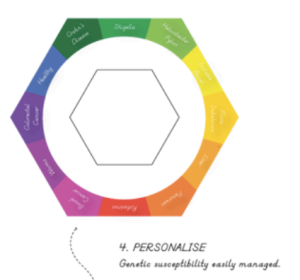
A Biological Color Wheel: diseases can be identified based on their color secreted in the body by these engineered bacteria
Source: Drew Endy, Stanford bioengineering
Seven students at Cambridge University are developing a rainbow of E. coli that could change how diagnostics are made in medicine.
These students genetically engineered bacteria to secrete a variety of different colored pigments, visible to the naked eye. The pigments were given to artists and designers at the Royal College of Art, who then made a probiotic, E. Chromi, which contain genetically encoded sensors for different diseases. The bacteria would be different colors depending on the health of one’s gut, and the color would determine which doctor a patient would need to see for care.
Despite its recent development, this technology will not be available to the open market until 2049. However, this provides an example of how medicine can be expanded and how biology can be instrumented as diagnostics for people, regardless of where in the world they may be from. By giving designers and artists biological materials with which they can experiment, new perspectives can be provided on developing technologies, making advancements never imagined before.
Source: echromi.com




